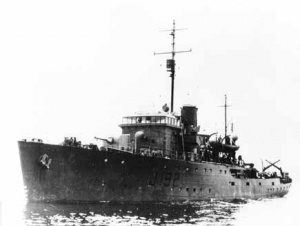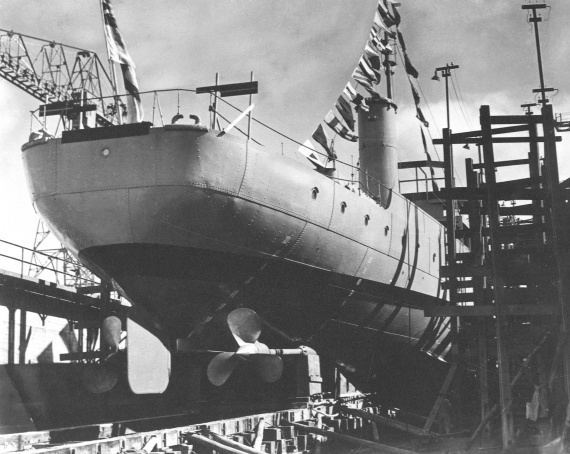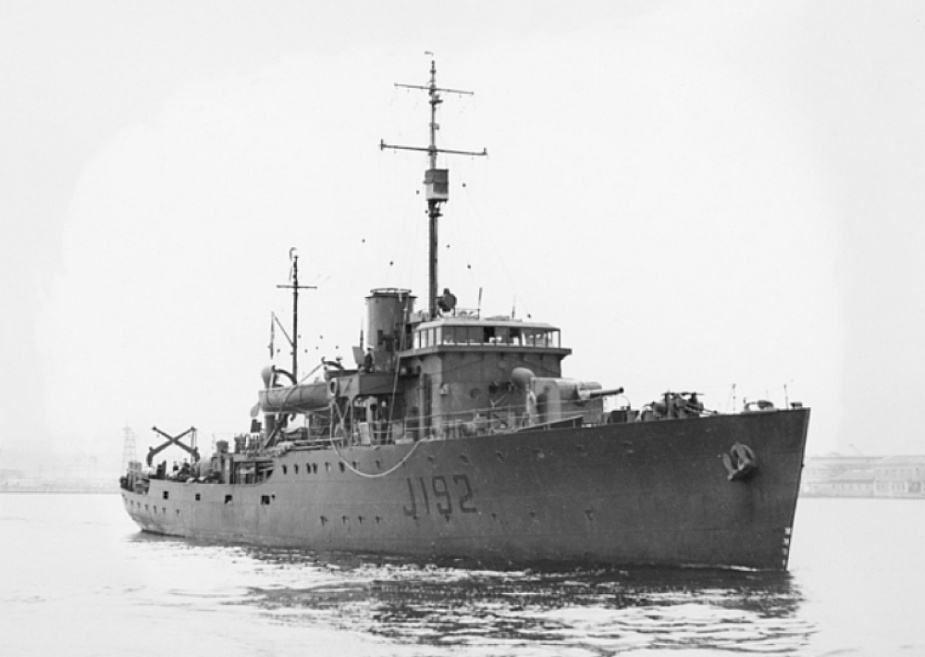HMAS Kalgoorlie
| Class |
Bathurst Class |
|---|---|
| Type |
Australian Minesweeper |
| Pennant |
J192, B245, A119 |
| Builder |
Broken Hill Pty Ltd |
| Laid Down |
27 July 1940 |
| Launched |
7 August 1941 |
| Launched by |
Mrs Playford, wife of the Premier of South Australia |
| Commissioned |
7 April 1942 |
| Decommissioned |
8 May 1946 |
| Dimensions & Displacement | |
| Displacement | 650 tons |
| Length | 186 feet |
| Beam | 31 feet |
| Draught | 8 feet 6 inches |
| Performance | |
| Speed | 15 knots |
| Propulsion | |
| Machinery | Triple expansion, 2 shafts |
| Horsepower | 1750 |
| Armament | |
| Guns |
|
| Other Armament | 3 x Oerlikons |
| Awards | |
| Battle Honours | |

HMAS Kalgoorlie was one of sixty Australian Minesweepers (commonly known as corvettes) built during World War II in Australian shipyards as part of the Commonwealth Government's wartime shipbuilding programme. Twenty (including Kalgoorlie) were built on Admiralty order but manned and commissioned by the Royal Australian Navy. Thirty six were built for the Royal Australian Navy and four for the Royal Indian Navy.
HMAS Kalgoorlie was laid down at Broken Hill Pty Ltd, Whyalla, SA on 27 July 1940. She was launched on 7 August 1941 by Mrs Playford, wife of the Premier of South Australia and was the first RAN warship to carry the name of the city, which is located 595 kilometres east northeast of Perth, WA.
Kalgoorlie commissioned at Whyalla on 7 April 1942 under the command of Lieutenant Harold A Litchfield RANR(S).
After carrying out trials in Port Phillip Bay, Kalgoorlie commenced operational service in June 1942 on convoy escort duties on the east coast of Australia. On 28 July 1942 she sailed from Sydney for Darwin, arriving via Townsville on 9 August.
Having transferred to Darwin, Kalgoorlie was employed on further convoy escort duties between Thursday Island and Darwin. During September 1942 Kalgoorlie transported troops to Timor and on 25 September, in company with her sister ship HMAS Warrnambool, safely evacuated the ship's company of HMAS Voyager, which had run aground at Betano Bay, in Timor, two days earlier.
In November 1942 Kalgoorlie operated in support of Operation LIZARD III, a clandestine Services Reconnaissance Department operation in Timor. During the following month, December 1942, and under sporadic air attack, she searched for survivors of HMAS Armidale, which had been sunk on 1 December, rescuing 20 personnel from a damaged motor boat on 6 December. Three days later she rescued a further 29 survivors from Armidale's whaler.
Kalgoorlie continued to escort convoys between Darwin and Thursday Island until late February 1943 when she returned to the Australian east coast. From April to December 1943, Kalgoorlie escorted convoys on the east coast of Australia.
During this period only one ship in a convoy escorted by Kalgoorlie was lost by enemy action. Convoy GP55 departed Sydney for Brisbane on 15 June 1943, and comprised 10 merchant ships, three American Landing Ships Tank (LSTs), and was escorted by Kalgoorlie and her sister ships HMA Ships Warrnambool, Deloraine, Cootamundra and Bundaberg.
On 16 June, with the convoy east of Smoky Cape, the SS Portmar was struck by a torpedo and sank within 10 minutes. LST 469 was damaged by another torpedo and towed to the safety of port. Kalgoorlie then conducted an unsuccessful search for the attacking submarine throughout the following days.
Between January and June 1944 Kalgoorlie carried out escort duties between north Queensland ports and New Guinea. She reverted to the east coast of Australia for the remainder of the year, with the occasional visit to New Guinea.
In August and September 1944, Kalgoorlie and her sister ship HMAS Pirie commenced the clearance of defensive minefields that had been laid in the through the Great Barrier Reef by HMAS Bungaree in 1942 and 1943. A total of 491 mines were swept during these initial mine clearance operations.
In December 1944 Kalgoorlie joined the 21st Minesweeping Flotilla, British Pacific Fleet. In January 1945 she visited Hobart and in late February sailed for the forward areas, reaching Ulithi Atoll on 24 March 1945 and Leyte Gulf in the Philippines on 31 March.
Kalgoorlie continued to operate in the forward areas until she arrived in Brisbane of 15 July 1945 for refit. She was still in refit at Brisbane when hostilities ceased on 15 August 1945.
Departing Brisbane on 26 September 1945, Kalgoorlie returned to New Guinea waters. She returned to Australian waters in January 1946 and between 2 and 10 March 1946 visited Esperance in Western Australia to pay a visit to her namesake town of Kalgoorlie.
Kalgoorlie paid off at Melbourne on 8 May 1946, having steamed 131,607 miles. On the same day Kalgoorlie was transferred to the Royal Netherlands Navy and renamed Ternate.
Note: This video is hosted on YouTube. Department of Defence users will not be able to view this video on the Defence Protected Network.
This cine film has been placed online as part of the Sea Power Centre - Australia's ongoing archival digitisation program.
Further reading
- The Corvettes: Forgotten Ships of the Royal Australian Navy by Iris Nesdale - published by the author, October, 1982.
- Notable Service to the Empire: Australian Corvettes and the British Pacific Fleet, 1944-45 by Hugh Campbell - published by Naval Historical Society of Australia Inc, 1995.
- Corvettes - Little Ships for Big Men by Frank B Walker - published by Kingfisher Press, NSW, 1996.
- The Australian Centenary History of Defence Volume III, The Royal Australian Navy edited by David Stevens, Oxford University Press, South Melbourne, Victoria, Australia, 2001.












